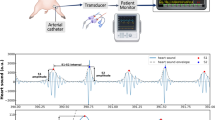Abstract
Esophageal stethoscope is less invasive and easy to handling. And it gives a lot of information. The purpose of this study is to investigate the correlation of blood pressure and heart sound as measured by esophageal stethoscope. Four male beagles weighing 10 to 12 kg were selected as experimental subjects. After general anesthesia, the esophageal stethoscope was inserted. After connecting the microphone, the heart sounds were visualized and recorded through a self-developed equipment and program. The amplitudes of S1 and S2 were monitored real-time to examine changes as the blood pressure increased and decreased. The relationship between the ratios of S1 to S2 (S1/S2) and changes in blood pressure due to ephedrine was evaluated. The same experiment was performed with different concentration of isoflurane. From S1 and S2 in the inotropics experiment, a high correlation appeared with change in blood pressure in S1. The relationship between S1/S2 and change in blood pressure showed a positive correlation in each experimental subject. In the volatile anesthetics experiment, the heart sounds decreased as MAC increased. Heart sounds were analyzed successfully with the esophageal stethoscope through the self-developed program and equipment. A proportional change in heart sounds was confirmed when blood pressure was changed using inotropics or volatile anesthetics. The esophageal stethoscope can achieve the closest proximity to the heart to hear sounds in a non-invasive manner.


Similar content being viewed by others
References
Miller Ronald D. Miller’s anesthesia. 7th ed. New York: Elsevier; 2009. p. 1267–85.
Kobza R, Roos M, Toggweiler S, Zuber M, Erne P. Recorded heart sounds for identification of ventricular tachycardia. Resuscitation. 2008;79:265–72.
Clarke WB, Austin SM, Shah PM, Griffin PM, Dove JT, McCullough J, Schreiner BF. Spectral energy of the first heart sound in acute myocardial ischemia. A correlation with electrocardiographic, hemodynamic, and wall motion abnormalities. Circulation. 1978;57:593–8.
Meno F, Reddy PS, Bernardi L. Heart sound propagation in the human thorax. Clin Phys Physiol Meas. 2001;6:123–9.
Yon JH, Han SO, Lim YH, Kim KM, Lee YS, Hong KH. Experience of phonocardiogram during the mitral valve replacement. Korean J Anesthesiol. 2000;39:275–7.
Lee JS, Lee BG, Kim DO, Kim YS, Cha TJ, Joo SJ, Lee JW. Evaluation of left ventricular systolic function by-M-mode echo/phonocardiography and automated border detection echocardiography. Korean Circ J. 1996;26:992–8.
Bloch KE, Jugoon S, Sackner MA. Thoracocardiographic-derived left ventricular systolic time intervals. Chest. 1994;106:1668–74.
Manecke GR Jr, Nemirov MA, Bicker AA, Adsumelli RN, Poppers PJ. The effect of halothane on the amplitude and frequency characteristics of heart sounds in children. Anesth Analg. 1999;88:263–7.
Stein PD, Sabbah HN, Khaha F, Anbe DT. Exporation of the cause of the low intensity aortic component of the second heart sound in nonhypotensive patients with poor ventricular performance. Circulation. 1978;57:590–3.
Xu J, Durand LG, Pibarot P. A new, simple, and accurate method for non-invasive estimation of pulmonary arterial pressure. Heart. 2002;88:76–80.
Hsieh BP, Unver K, McNulty E, Schiller NB. The amplitude ratio of the first to second heart sound is reduced in left ventricular systolic dysfunction. Int J Cardiol. 2010;145:133–5.
Amit G, Shukha K, Gavriely N, Intrator N. Respiratory modulation of heart sound morphology. Am J Physiol Heart Circ Physiol. 2009;296:796–805.
Erne P. Beyond auscultation–acoustic cardiography in the diagnosis and assessment of cardiac disease. Swiss Med Wkly. 2008;138:439–52.
Acknowledgments
This research was supported by Basic Science Research Program through the National Research Foundation of Korea funded by the Ministry of Education, Science and Technology, 2010.
Conflict of interest
The authors declare that they have no conflict of interest.
Author information
Authors and Affiliations
Corresponding author
Rights and permissions
About this article
Cite this article
Park, S.H., Shin, Y.D., Bae, J.H. et al. Heart sounds analysis via esophageal stethoscope system in beagles. J Clin Monit Comput 27, 535–539 (2013). https://doi.org/10.1007/s10877-013-9459-0
Received:
Accepted:
Published:
Issue Date:
DOI: https://doi.org/10.1007/s10877-013-9459-0




